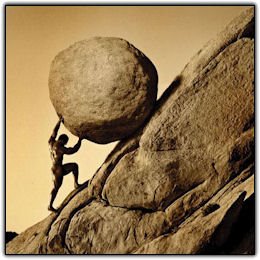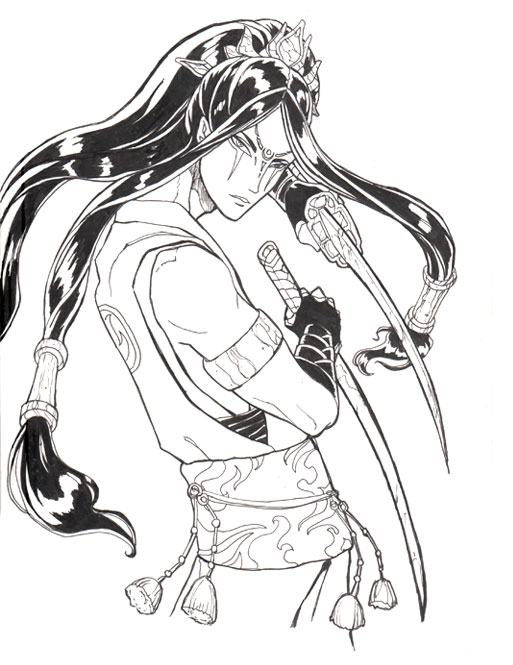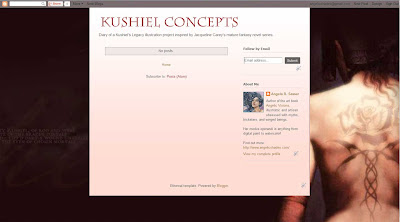 |
| Sisyphus – the story of my life. |
Once again, I am inspired by The ArtOrder’s latest portfolio-building exercise and what I’ve learned lately about my work, my regrets, and my future as an artist.
All of my art supplies are in boxes right now and I am here sitting on the verge of a big change in my life. I’m moving to a new area with my significant other as well as taking the first steps to realizing a strategy I have been ruminating on to re-invent my art and myself.
All of this pondering on who I am and where I’m going has me realizing that there is little divide between who I want to be as an artist and what I want to be doing as a career. I’ve looked back on my own work and realized that I’ve only started painting the things I want to paint in this past year. I’ve made due in the past by trying to fit my art into a box (the fine art box, the licensing box, etc. etc.) just so I can be doing art and making money, ANY kind of money, so I could call myself ‘successful’ at this livelihood as long as I’m doing something creative. My approach to being successful has been completely backwards.
I’ve been struggling in my career as an artist, unable to find a focus that I felt fit me 100% or to achieve the kind of monetary success I want. It’s taken experimentation, a good deal of floundering with jobs I grew bored with, and a great sense of failure that I’ve had to overcome to get to this point. I’ve struggled with the advice from others that “Not every job is going to be interesting so you need to compromise to pay the bills”. This is true to an extent, but I realize now that if I’m bored with my work 90% of the time, there are far easier ways to be bored (and get paid better) than stagnating in a field of art that is more destructive to my drive in life than useful.
I’m sacrificing a lot to be an artist and I think where I end up in this career should justify the hardships of pursuing it, not just let me ‘settle’ because I’m doing something creative, therefore I should be happy. I need more than monetary success, I want Mastery. From every Master I have had the pleasure of meeting lately, this has been the constant secret ingredient. Their passion has led them to the top of their game and to monetary success. Companies seek them out because they show drive to mastery, professionalism, and focused specialization. And by specialization, I mean that art directors think “I’ll hire this artist because I know them to be very good at drawing X thing, which fits my project perfectly!” When you’re a jack of all trades, nobody can really identify anything with you, or they identify the *wrong* thing with you (ie. I think I’m better known for my leather masks now than my actual paintings. Funny how that worked out!)
Getting to know myself better as well as asking myself some tough questions in the Painting Drama class and the ArtOrder’s portfolio-building series have really peeled away a film of indecisiveness that I have been blinded with for a long time. It’s no coincidence to me that both of these places didn’t jump right into ‘what are your technical skills like’ at the beginning of the program. Instead, the very first thing you do in both is to ask intensely internal questions.
Who are you? What are you passionate about? Where might your passions fit in to the art industry?
It’s no wonder Jon calls this exercise “The Insanity Loop” where we do the same thing the same way and get the same results. How many times have I written in this journal that I’ve formulated a strategy to enter a particular field of art, only to find what I am trying to do wasn’t right for me after all and then I am sent right back to square one where I’m not getting any of the kind of work I want?
The answer for me has been a simple one. I am not presenting the kind of art I want to be doing, rather I’m maintaining a status quo of doing the work that keeps my head above water. True, we all have to pay bills, but again, I’ve reached this breaking point where I realize I could be working at a different profession and make more than I’m making now with art. The pure act of creating is not enough to maintain my happiness and well-being in life. The mental strain of not being successful at what I’m doing with my art or actually painting the kind of work I want to paint has made me realize that it’s make or break time.
I need to aim higher than I am and figure out a better strategy than ‘do art and they will come’. I needed specific strategic planning and that is what I am finally doing by asking the tough questions I wasn’t asking before, or accepting the answers that I was afraid to act on for lack of my own confidence.
Apparently it’s been a rather cathartic couple of months for me! I finally feel I’m on the right path in my career. I’ve got a strategy to paint the types of things I have always wanted to paint and I am far more confident that this simple baby step forward will help advance my career in ways that mere blind enthusiasm hasn’t in the past. It’s taken this turning of a harsh lens inward to realize what I’ve been doing wrong.
I hope this rambling has proven useful to someone else out there who might be trying to figure themselves and their goal out. A lot of us start out with such a broad expectation of ‘I’m going to draw and get paid for it!’ but then let our experimental nature and broad artistic interests distract us from applying a pointed strategic approach to anything. Another important lesson I have learned recently is that there is a difference between an interest and a passion. A passion is what my career will be. An interest is where I will spend my time having fun without the worry of judgements or money.
Jon’s portfolio-building series has been one strategizing method which has worked for me. Maybe it will work for you too? I’d love to hear your thoughts and feelings in comments, if you’ve taken on this exercise for yourself. Share with me! I don’t want to be the only one rambling here.




